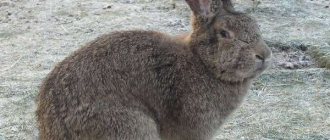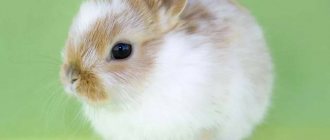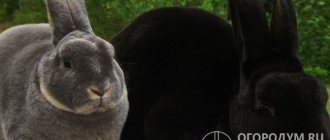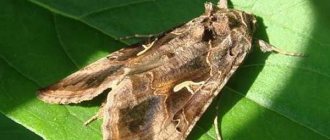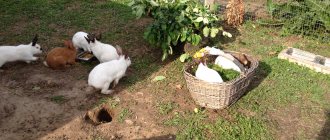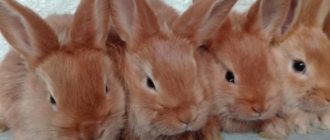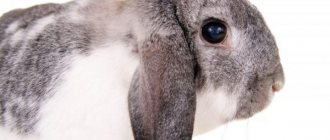The butterfly rabbit is a popular breed among rabbit breeders in Russia. The animals will captivate the hearts of breeders with their appearance, friendliness, ease of cultivation, and productivity.
Butterfly rabbits are meat-and-skin animals that can be found both on farms and in apartments, as pets. Dietary quality meat with an unsurpassed aroma is obtained from the animals. The original colors of the skins make it possible for fashion designers all over the world to sew beautiful clothes from it. When bred at home, such a rabbit becomes not just a pet, but a true friend to man.
Origin story
Photo:
Back in the 19th century, skillful Englishmen managed to breed a special breed of rabbit, called the Butterfly due to its bizarre color shape, reminiscent of the silhouette of a butterfly. Moreover, the weight of one rabbit then ranged from 3 kilograms.
Subsequently, based on the dwarf Butterfly, rabbit breeders from different countries began carefully breeding other varieties for their needs. Already our geneticists decided to correct such decorativeness by increasing the weight of the animal and improving the overall quality of the fur.
It was also necessary to adapt to the harsh climate by crossing with breeds such as the White Giant, Vienna Blue, Soviet Chinchilla and others, thanks to which individuals were able to reach an average weight of 5 kilograms. Butterfly rabbits were transformed from decorative breeds into meat-hide rabbits.
Butterfly rabbit breed: unique coloring and high productivity
Among the owners of rabbit farms and ordinary lovers of this type of pet, the butterfly rabbit breed is very popular. This breed got its name due to its original coloring: the presence of a characteristic spot on the face.
- 1 History of the breed
- 2 Description and characteristics of the breed with photographs
- 3 Necessary care and maintenance requirements
- 4 Diet and feeding
- 5 Advantages and disadvantages of the breed
- 6 Breeding at home 6.1 Caring for rabbits
- 6.2 Vaccination of rabbits
Description of the breed
Characteristic:
- The constitution is strong, the meatiness is good.
- The body is dense, 54-60 cm long;
- The head is medium, round, large in males and oblong in females;
- The chest is deep and wide, with a girth of 36 cm, often with a slight dewlap;
- The back is elongated and wide;
- The croup is round and wide;
- The limbs are strong, straight and muscular.
- Females have good milk production and fertility - on average 8 rabbits per litter. They have good maternal qualities.
- The young animals are early maturing and fatten well.
- The average weight of butterfly rabbits is 4.3 kg (4.0-4.5).
- The ears are dark;
- Large and straight paws;
- The fur is elastic, shiny, medium-thick and even. Piebaldity (spotting, partial albinism) of the pattern gives the skin an original elegant look.
- The color of rabbits is white with black spots scattered symmetrically on the back and sides. In some rabbits, these spots are lighter - blue, gray, chocolate shades.
Description and characteristics
| Characteristics of the main indicators | |
| Body constitution | Strong backbone |
| Body length | Up to 60 cm |
| Meatiness | Increased |
| Head | Oval, medium size. |
| Rib cage | Wide; girth - up to 36 cm; sometimes there is a dewlap. |
| Back | Expanded, elongated. |
| Croup | Wide, roundish. |
| Paws | Muscular, strong, straight. |
| Adult weight | 3.8 - 4.7 kg (may be less depending on the variety). |
Breed standard:
- Eyes. Dark. There is a border around them (can be of any color).
- Ears. Erect, dark, plain.
- Fur. With a sheen, elastic, medium density, smooth.
- Color. White with black. There is a dark stripe along the back, and symmetrical spots on the sides. Sometimes there are rabbits of blue, gray, and brown shades.
- Features of females. Dark spots around the nipples.
- Distinctive feature. There is a dark spot around the nose that resembles a butterfly in shape, and piebaldness (spotting) on the body.
Varieties
The butterfly undoubtedly belongs to a fairly large breed of rabbit. Although, of course, everything depends on the specific variety that the rabbit breeder decided to purchase. To do this, you should familiarize yourself with the main characteristics of the most popular rabbit breeds.
Dwarf
The smallest breed of Butterfly. The ancestor of the entire breed. Due to its size and good disposition, it can be kept as a pet. Has all the necessary features necessary for successful breeding.
Main parameters:
- average weight - up to 3 kilograms;
- cylindrical body, beautiful back line and rounded back;
- large head (for a dwarf breed);
- protruding ears, close to each other, round tips;
- The lifespan of an individual is up to 6 years.
Motley Giant
The rabbit is the largest of all butterflies, so keeping it as a pet is extremely troublesome. At the same time, it is ideal for farm breeding: there will be plenty of fur and meat.
Main parameters:
- the weight of this variety ranges from 5 to 10 kilograms;
- body length 56-66 cm; the head is of medium shape, round in males, oblong in females;
- wide chest, females may have a dewlap;
- somewhat elongated body, but at the same time quite dense;
- arched back;
- paws are of medium length, straightness and strength;
- white color with black and blue patterns.
Czech butterfly
Its golden fur will not leave any rabbit breeder indifferent. Due to its medium dimensions, it is perfect for farming.
Main parameters:
- weight from 2 to 4 kilograms;
- strong, strong cylinder-shaped body;
- the chest may have a dewlap;
- strong and strong paws of a straight shape;
- there are no spots on the stomach and chest;
- slightly elongated head;
- ears are straight, medium length;
- the coat is even and may shine; X
- the east is small, white below.
Rhine rabbit
Having appeared on the banks of the harsh Rhine, this variety of Butterfly managed to gain good fame among rabbit breeders in different countries. He has a good disposition.
Main parameters:
- the color scheme of his coat: white, black and golden red;
- brown eyes;
- the weight of an adult rabbit is from 3 kilograms;
- females are heavier than males;
- the body has the correct cylinder shape;
- hips the same width as shoulders;
- the hind legs are quite strong and rounded;
- The wool is dense and pleasant, similar to silk.
English butterfly
This particularly exquisite breed of Butterfly is famous for its cheerful character and extraordinary intelligence. They need a lot of space to play.
Main parameters:
- a bright, fit rabbit with well-groomed fur;
- the head is small, oblong, with a fairly clear profile;
- ears are straight and stand close;
- weight from 2 to 4 kilograms;
- females are larger than males per kilogram; the fur is elastic, quite elastic;
- color varies within five colors: black, blue, chocolate, tortoiseshell, gray and purple;
- there is a black spot in the shape of a butterfly on the rabbit’s nose;
- on the cheeks there are small round spots of the same size;
- The average life expectancy is from 8 to 12 years.
How to choose a good rabbit
When purchasing, pay attention to the following:
- The animal should not weigh too little. This happens due to poor nutrition and other reasons.
- Purebred. Deviations from the standards indicate violations during crossing. This means that the offspring will not have the quality of fur and meat that purebred representatives of the breed produce.
- Find out if there are problems with the spine. When animals are kept in cramped cages, abnormalities are clearly visible, especially in young animals. With pathologies of the spine, internal organs and systems suffer.
- They check for signs of degeneration: abnormal body proportions, altered skull shape, different type of coat, visible emaciation. Such individuals are born as a result of mating of relative rabbits.
- Symptoms of diseases, pathologies. They take the animal in their arms and examine it. There should be no parasites in the ears. Teeth that are too large have a negative impact on health and well-being, as they interfere with eating normally.
If butterfly rabbits have passed the test, you need to look at their parents. It is important to see the conditions in which they live. This also affects the quality of the offspring.
Reviews
According to customer reviews, the advantages of the breed include:
- unpretentiousness in care and maintenance;
- much less feed is needed than when keeping large individuals;
- distinct pattern on the coat;
- there is no need to build large cages for these rabbits;
- Possibility of keeping as a pet.
The disadvantages include the low productivity of the breed. The skins, although very beautiful, are small, and the meat is more than 1.5-2 kg. you can't get it from a rabbit.
Owner reviews
Oleg, 42 years old, Ryazan region
My parents kept rabbits of this breed for many years. My father processed the skins himself, fortunately there was a sales channel. Now I have 6 female rabbits and a rabbit. All are purebred, purchased from a good breeder. I don’t see any problems with maintenance, feeding and care. The animals are practically problem-free: they don’t get sick and reproduce regularly. Feeding costs are minimal, especially in summer. It is clear that preventive vaccinations should not be neglected (no “greenhouse” conditions can save you from diseases such as VGBV). But otherwise, everything is fine. I prefer Butterflies to all other breeds (including the vaunted giants).
Irina, 36 years old, Kursk
I have cages with Butterflies in an unheated barn. In winter the temperature is the same as outside. Females rabbit in the cold, almost all babies survive. Female rabbits are wonderful mothers: they wrap their babies in down and feed them. Of course, we must ensure that the animals always have water and that their cages are dry and clean. Those who are just starting to keep rabbits probably have difficulties, but when you get used to it, you realize that there is very little hassle with them. But there is always the opportunity to get a portion of excellent meat. And the skins of this breed are very high quality, especially if you have someone to process them. Excellent rabbits: reliable and unpretentious. For a personal backyard - one of the best.
Sergey, 52 years old, Orel
This breed is perhaps the most convenient for beginner rabbit breeders. I got it first, many years ago. Then I kept other rabbits, but now I understand that “Butterflies” were the easiest to care for. No whims with food, no hysterics about heat or cold. I vaccinated them on time, making sure that there was no dampness or drafts in the cages. He prepared good hay, gave him vegetables and a little barley, and did not leave him without water. That's all there is to worry about. And the births always turned out decent, and the yield of meat was satisfactory. Good breed. I recommend it to everyone.
Productivity
Butterfly rabbits provide a large amount of tasty and tender meat. From one rabbit you can get up to 4.5-5 kg. The female brings up to 8 rabbits.
She has a well-developed maternal instinct, so the rabbits basically all survive. In a year, a breeder can get a very good offspring.
Butterflies make excellent skins that look great in their natural state. They don't need to be painted. And if you consider that the spots can be yellow or blue instead of black, then you can make so many beautiful things from this splendor!
Origin and characteristics of the breed
The breed was bred in 1884 in England as an ornamental dog. Dwarf (weighing up to 2 kg) animals with original colors were very popular in Western Europe at the end of the 19th and beginning of the 20th centuries. This is how the “Butterflies” came to the territory of our country. Soviet breeders did a great job trying to improve the breed, changing it to increase meat productivity and resistance to more severe climatic conditions. As a result of many years of crossing larger varieties with rabbits, animals were bred, from which today they obtain both the most tender meat and beautiful fur of very high quality.
The spots characteristic of the breed's color are most often black, but can be brown or bluish-gray
Purebred Butterfly rabbits look extremely impressive in the photo. These are very beautiful animals, with short but shiny, delicate and thick fur. The main color of the skin is white. The body is covered with black (less often, brown or bluish-gray) spots, forming a regular pattern, symmetrical with respect to the ridge. A long, jagged stripe at least 3 cm wide runs along the entire back. The dark eyes are also “outlined” in black. The ears are medium size, fully colored. Nose is black. Around it is a butterfly-shaped spot, which gives the breed its name. The remaining spots are “scattered” on the sides and cheeks. They are small, each has clear boundaries. Adult females are characterized by the presence of a black “edge” of the nipples.
The animals have a dense build. The chest is wide (circumference is 36-38 cm). The head is small, the muzzle is elongated. Ears are erect. The paws are strong and powerful. The weight of an adult reaches 5 kg (females are usually slightly smaller than males).
Rabbits are mother-fed for about 1.5 months, and then they are transferred to an adult diet
Rabbits can begin to mate at the age of 4 months. As a rule, each one brings 8 babies per litter and successfully feeds the offspring. By one and a half months, the rabbits have already completely switched to the “adult” diet, and at 5 months, young animals, not intended for reproduction, reach a weight of about 4.5 kg, which is considered optimal for slaughter . The meat yield is about 60%, the product quality is very decent. In addition, each animal produces a wonderful skin that can be used without prior dyeing. The dense, delicate and elegant fur of “Butterflies” is highly valued and is in great demand on the market.
Breeding
Due to the fact that Butterfly rabbits mature very quickly, they must initially be placed in different cages. Before this, the pet’s gender is reliably determined: a split triangle indicates a female, and a tube indicates a male.
The youngest age for mating is 4 months. If you do this earlier, the health of the animals and their offspring will be significantly damaged. Butterflies breed throughout all seasons, so there are no restrictions on this. Although, only pets in excellent health can afford to mate all year round.
Farmers and rabbit breeders with experience practice the following breeding schedule:
- winter period (from January 15 to February 1);
- spring period (from April 1 to April 15);
- summer period (from June 1 to June 15).
It should be noted that males of the Butterfly breed should be used in mating as often as possible. Long breaks lead to health problems. In this situation, it is optimal to establish interaction between 1 male and 8 females.
The female needs to be checked for readiness for sexual activity. It is most often expressed in swelling and redness of the genital loop.
At the same time, the female behaves restlessly, scatters fluff everywhere and prepares bedding for herself. This condition lasts for several days.
The first sexual intercourse of a female should occur with the most experienced male. If the female herself has the necessary experience, then she is mated with a younger one.
A week later, another control mating occurs. If the female became pregnant during the previous sexual intercourse, then she does not allow the male to approach her anymore.
After another two weeks, a final check should be carried out and the presence of pregnancy should be checked by palpating the rabbit’s belly.
Breeding baby rabbits of the Butterfly breed
For breeding, it is worth buying purebred individuals at 3-4 months of age. Moreover, you need to contact only specialized farms or farms, otherwise there is a risk of buying non-purebred rabbits. The young animals need to be carefully examined to make sure that their spine or one of their legs is not bent. The nose and eyes should be clean, without purulent discharge. In addition, excessively low weight is unacceptable. According to a similar scheme, individuals are selected to renew the rabbit population.
Baby rabbits
Subtleties of rabbit mating
Rabbits are ready to mate when they reach 4-5 months. The fact that the female rabbit is ready for mating is indicated by her excessive hyperactivity and reddened genital loop. When breeding, you should pay attention to a few tips:
- The male should be slightly older than the female rabbit.
- In summer, animals are inclined to mate in the morning, in other seasons - at any time during daylight hours.
- Mating is best done in the partner's cage. If he is placed in a cage with a female rabbit, he will need time to study the situation, and he will not immediately cover the female. Immediately after mating, the female is returned to her cage.
- If the female rabbit did not allow the rabbit to approach her the first time, it means that she is not yet ready for mating and is exhausted from previous births. The couple should be seated and the procedure repeated after a few days.
- Do not forget that Butterfly rabbits cannot be crossed with rabbits of other breeds. This significantly deteriorates the quality of meat and skin.
Signs of pregnancy in a rabbit
In theory, the body of the mother who gave birth is ready for a new mating within 2-3 days after the birth of the rabbits. But with this approach, the female’s body will quickly wear out, and the rabbits will be born weak and exhausted. Give the female time to rest. One or two months will be enough, since mating too infrequently can also be harmful.
Males are slightly larger than female Butterfly rabbits
Preparation and childbirth
The entire process of preparation and birth of a rabbit comes down to several sequential steps. They are presented in the table below.
Table 2. Preparation and childbirth
| Step, no. | Description | Photo |
| Step 1 | To make childbirth comfortable, you need to prepare a cage for the rabbit in advance. It is insulated and equipped with a queen cell. | |
| Step 2 | Gestation of cubs lasts on average 29-32 days. If the female has recently given birth, the cubs should be removed from her 4-5 days before giving birth. Otherwise, she will refuse to build a nest and will scatter the newly born babies around the cage. | |
| Step 3 | 3-4 days before giving birth, the rabbit herself will begin to prepare for the event. She builds a cozy nest and insulates it with her down. | |
| Step 4 | The birth process lasts no more than 15 minutes. Immediately after giving birth, you need to give the female a drink of clean water; she will be very thirsty. If there is no drinking bowl with water in the cage, the mother can eat her newborns without a twinge of conscience. |
Rabbits of this breed are rarely bad mothers for their children. But in rare cases, an inexperienced female can scatter the cubs around the cage and ignore all their attempts to get to the mother's nipples with milk. In this case, you should rub your hands with rabbit fluff, collect the babies and send them back to the cage. If this does not help, the newborns should be transplanted to a more responsible rabbit.
What to do with kids?
For the first 14 days of life, babies feed exclusively on mother's milk, so you shouldn't interfere with upbringing unless absolutely necessary. At the age of 3-4 weeks, they themselves begin to try the food that their mother eats. Therefore, one month of age is the best time to accustom them to adult food. By the age of 40-45 days, young animals completely switch to a dairy-free diet.
Important! You should start transitioning baby rabbits to adult food carefully and gradually. New types of food should be introduced into the diet gradually. At the same time, solid food cannot be given immediately; at first, babies are fed foods with a more delicate consistency.
Growing rabbits in the nest
You can read about how to care for newborn rabbits in our special article.
Content
Butterfly rabbits can be kept both in apartments and in houses, but with the obligatory cage equipment. Moreover, if it is inconvenient to keep a large rabbit at home, then the dwarf variety of Butterflies is quite suitable for this.
It is better to purchase a small pavilion in which you plan to keep animals. Rabbits feel great wherever they are given a small but cozy place without drafts.
It is also possible to create housing for eared pets yourself. In this case, it is enough to use the construction model proposed by N.I. Zolotukhin.
Cage according to cx. Zolotukhina
It looks like a cage consisting of three floors, assembled from materials such as wood, welded mesh, slate, sheet metal and polycarbonate.
To construct it correctly, you must adhere to the following technique:
- use wood to make strong doors to the queen cell, partitions, and frames;
- made of welded mesh – checkered doors, as well as the back of the floor;
- put a good slate in place of the main floor: it also serves as a ceiling for the lower rabbit cell;
- the door is inserted using polycarbonate - so that the big-eared ones do not damage the beams, they must be covered with sheet metal
Since “butterflies” tolerate weather fluctuations well, they can be kept outside. Moreover, this option is even preferable, since “street” rabbits acquire thicker and more beautiful hair, which directly affects the quality and cost of the skins.
The only thing you need to remember is that you should not allow strong drafts in the rabbit’s home.
Maintenance and care
Keeping butterflies can be done in several ways - cage, semi-free, penned. The ideal option would be to live in cages. This method allows for complete control over the process of feeding and mating of rabbits, as well as calculating the gestation period of females.
Keeping them in cages allows you to regularly and without much difficulty carry out preventive work to combat various diseases. Helps prevent the massive spread of bacteria. Animals do not require too large territories; most importantly, drafts should not be allowed.
Content Features
Butterflies cannot be called picky, so even novice farmers who have not worked with rabbits before can keep them. In addition, they can become wonderful pets; all you need to do is purchase a small cage and nothing else is required.
Factory, in enclosures/pavilions
It is better to take a pavilion for keeping rabbits that is not too large. Animals feel quite comfortable under different conditions, especially if a not too large, but cozy and warm place where there are no drafts is equipped for them.
If you wish, you can build housing for your pets yourself. An excellent choice would be a pavilion, which consists of three floors. For manufacturing, use natural wood, slate, welded mesh, polycarbonate and sheet metal.
To properly build a cage, follow these tips:
- Build wooden doors into the queen cell, also make a wooden frame and partitions;
- use welded mesh for cage doors and rear floor equipment;
- slate will be an excellent option for the main floor; also use it for the ceiling of the lower cells;
- Insert doors using polycarbonate; animals can damage the beams, so cover them with sheet metal.
Do not forget that animals constantly need fresh air, so you can equip a pavilion or enclosure in the fresh air. This content will make the rabbits' fur thicker and denser.
The ideal option would be to adjust the content depending on the time of year:
- during warm periods, keep outside, but in a place where there are no drafts;
- in winter, move cages or enclosures indoors.
At home like a pet
When keeping animals as pets, it is better to use cages. To care for them, they need to be regularly ventilated, but avoid the formation of a draft. If possible, place the cage outside during the warm season, at least for a few hours. Such procedures will only benefit the animals - the fur becomes thicker, a beautiful shine appears, and appetite improves.
Make sure that butterflies have constant and free access to water and food. Don't forget to provide hard, fresh food so your rabbits can sharpen their teeth on it. If this is not done, they may begin to chew on the bars of the cage.
Feeding
Butterflies need a proper, and most importantly, varied diet. Meals must include:
- tree branches;
- in the summer - green grass, maybe a little withered;
- grain types of feed;
- in the cold season - fresh and fragrant hay;
- When fattening, it is recommended to use special concentrates;
- The diet must contain minerals and vitamin supplements.
Make sure there is always clean and fresh water in the cage. If you neglect this advice, the female may eat her offspring. If a female rabbit is very thirsty, she is able to completely forget about her own maternal instinct.
If you follow a few simple rules in nutrition, your pets will not only quickly gain weight, but also feel quite comfortable:
- When selecting products, make sure that the food is not spoiled, there are no signs of rot, and the expiration date of the food has not expired.
- Animals need to be fed at least twice a day, preferably at approximately the same time of year.
When and what to feed rabbits, read here.
- In the summer, green types of food must be present on the menu.
- Keep the cage perfectly clean - change the bedding at least once every 2-3 days, wash the feeders and drinkers every day.
- Make sure that it is dry and warm in the cage, since dampness and dirt are the main causes of death for animals.
If favorable conditions and comfort are created, pets can live up to 10 years.
Diseases and preventive measures
Representatives of the described breed suffer from such dangerous diseases as necrotizing hepatitis and myxomatosis. These viruses can instantly infect the entire herd, infecting both adults and young animals. There is a risk of death and destruction of the entire herd.
These troubles can be easily avoided if vaccination is carried out in a timely manner as a preventive measure. It is recommended to vaccinate baby rabbits immediately after weaning from their mother. In the first weeks after birth, young animals have the strongest immunity, which becomes possible thanks to breastfeeding. The protective property can last for 3 months.
It is recommended to vaccinate animals weighing at least 0.5 kg. The first vaccination is given at the age of 6 weeks, but 10 days before the procedure, it is necessary to check the young animals for the presence of worms. If necessary, mandatory deworming is carried out.
When rabbits reach the age of 1 year, a comprehensive vaccination is performed. If you plan to breed butterflies, it is worth considering that vaccination of females cannot be done during pregnancy and lactation. Vaccination is contraindicated for sick animals.
During vaccination, weakened pathogens of hemorrhagic disease and myxomatosis enter the animal’s body, provoking the onset of the production of its own antibodies against hostile cells. The body of sick rabbits and pregnant females is already subject to high stress, so it is necessary to choose a different time for vaccination.
Feeding
The butterfly decorative rabbit is not at all picky about its diet. Like all other breeds, he will happily eat branches of fruit trees, grass, hay, vegetables, and crop waste.
True, rabbits of this breed get used to the lunch schedule more than others, so you should always feed the animals at the same time of day.
Particularly favorite delicacies for butterflies are clover and alfalfa, as well as young corn. To maintain good health of rabbits, it is recommended that they be given sugar beets, cabbage, boiled potatoes, carrots (tops can be used) and other vegetables.
Some rabbit breeders replace a significant portion of green feed with compound feed. In principle, this is acceptable, since grain crops do not harm rabbits. The only taboo is poultry feed, since shells can be added to it, which is contraindicated for rabbits.
The basic rules of feeding are not particularly exotic:
- Animals must have constant access to drinking water. Especially if their diet contains a lot of dry food (hay, grain, feed).
- To get tasty meat and high-quality skins, you need to feed rabbits at least twice a day.
- In addition to the main food, do not forget about feeding with vitamins.
- Solid plant food must be present in the cage at all times - tree branches, root vegetables, etc. Without them, rabbits will instinctively chew on the wooden boards that make up the cage.
- Rotten or spoiled products are not allowed.
- Queens and breeding males should not be overfed, as obesity has a bad effect on their reproductive abilities.
Conditions for keeping
Butterfly rabbits are a universal breed, as they are raised both in apartments and on farms.
At home, animals are kept in a room or on a balcony. It is worth remembering that the dwarf butterfly subspecies is better suited for home breeding. This will save space (small animals need small cages) and financial costs for food. Such rabbits will not be a source of meat or skins. But they will become great friends for people. The main thing is not to forget to spend time with furries, who are known for playfulness and pampering.
When breeding for slaughter, animals are raised in adapted premises with ventilation: enclosures, pens, rabbitries with ventilation. Keeping them outside significantly improves the quality of the coat, making it thicker and more beautiful. Therefore, it is recommended to take rabbits out into the fresh air during the warm season, and with the onset of cold weather, take the cages into heated rooms.
It should be ensured that animals are not exposed to direct sun or drafts. Butterfly rabbits easily adapt to weather fluctuations, so outdoor placement on a permanent basis is acceptable (except in areas with particularly harsh winters).
Attention should be paid to hygiene: cages should be cleaned daily, humidity should be controlled, and bedding should be changed. It is recommended to periodically disinfect rabbit hutches and equipment used in caring for animals.
Nutrition
Recommendations for feeding butterfly rabbits:
- It is advisable to feed rabbits 2 - 4 times a day according to a set schedule.
- Unlimited access to drinking bowls with clean water.
- The menu should include combined feed, hay or dried grass (according to the season), grain, root vegetables, twig food, and vitamin and mineral premixes.
- It is prohibited to provide low-quality (rotten, moldy) food.
- Control of consumption volumes so that long-eared animals do not suffer from obesity (reproductive functions decrease).
Butterfly rabbits are big gourmets. Periodically enrich their diet with “goodies” - clover, alfalfa, young corn, carrots, cabbage leaves, sugar beets.
Breeding
For breeding butterfly rabbits, “purebred” representatives of the species with the best quality characteristics are suitable. Butterflies reproduce throughout the year.
It is recommended to adhere to the following birth schedule: 1) Winter – January-February. 2) Spring – March-April. 3) Summer – May-June.
More frequent mating leads to rapid exhaustion of the rabbits. But male butterfly breeds, on the contrary, should be used more often (prevention of genitourinary diseases).
For 8 female rabbits, 1 male breeder will be enough. For mating, a sexually active female (in heat) is placed next to a male. After mating, the female is taken away. After 1-2 weeks, pregnancy is checked. If confirmed, the rabbit is transferred to a special diet, and a cage with queen cell is prepared. For a pregnant female, a home with dimensions of 0.5 x 1 m is prepared. Up to 8 rabbits are born in one litter. A cage with dimensions of 0.5 x 0.7 m is suitable for young animals.
Butterfly rabbits grow very quickly. At 3 months the animals become sexually mature. And by 4 months they are ready for slaughter.
To obtain purebred representatives of the breed, mating with other species is excluded. Crossbreeding degrades the productive qualities of butterflies.
Diseases and their treatment
The Butterfly breed suffers from myxomatosis and necrotizing hepatitis. Both viruses instantly cover the entire population, infecting both adult rabbits and baby rabbits.
Mortality can reach the entire mass of animals. These statistics already indicate that vaccination against these viruses is important and necessary. Therefore, in order to avoid illness and death of the Butterfly, it is necessary to carry out timely prevention.
The easiest way to vaccinate small rabbits is after removal from the female rabbit. At first, their immunity is quite strong thanks to feeding on mother’s milk, which retains its protective properties for another three months, after which the rabbits develop strong immunity.
The weight of the cubs is also important when deciding whether to vaccinate. It is recommended for weights of 0.5 kg.
During an epidemic, vaccinations can be given as early as one month of age. Vaccination must be repeated after another three months.
Instructions for administering the vaccine:
- Purchase high-quality vaccines against myxomatosis and necrotizing hepatitis.
- Review the information sheet that comes with the specific drug. It describes in detail the necessary vaccination methods and doses.
- Store and transport the vaccine carefully, avoiding freezing during the cold season. Or: if the vaccine is dry, dilute it with water for injection or a special solvent.
- Wait for a favorable climate, avoiding extreme heat, in which animals will need more time to recover from vaccination.
- Use the vaccine within 3 hours of opening.
- Follow the instructions and administer the vaccine correctly. The main place of vaccination is the ear and rib.
In special cases, after the injection, the rabbit may develop an allergy within the first 15 minutes. Its symptoms: the mucous membrane becomes very red; a rash appears on the skin; profuse shortness of breath appears; lethargy and even loss of consciousness.
When can rabbits be slaughtered after vaccination? There are no clear deadlines. But it is usually not recommended to do this within a week after vaccination due to possible inflammatory processes that reduce the value of the rabbit carcass.
History of the breed
Butterfly rabbits originate from England, where they were bred in the 19th century. Initially, the specimens obtained were decorative, but in the process of further improvement of the breed they grew to the standard size of meat rabbits. Breeders achieved such results by crossing with rabbits of other breeds.
The new breed quickly gained popularity all over the world, and even became the basis for obtaining national breeds in different countries. This is how the Motley Butterfly breed appeared in Germany, and the White Hotot in France.
When the butterfly breed appeared in Russia, the weight of rabbits did not exceed 2 kilograms, and they were considered decorative. Russian breeders set themselves the task of adapting the breed to a harsh climate and increasing its productivity. For this purpose, rabbits began to be crossed with the Soviet chinchilla, white giant, Flanders and Viennese blue. As a result of crossing, a breed was obtained that has excellent taste characteristics and weighs up to 5 kilograms.
Breeding prospects
“Butterfly” is a beautiful breed with good productivity indicators. However, today there are much more productive species that can produce more valuable skins and a higher yield of meat per carcass.
For this reason, breeding butterfly rabbits today is carried out almost exclusively by small farmers and amateur rabbit breeders. But large farms prefer to focus on large-breed rabbits, such as white and gray giants, Flanders, Soviet chinchillas, etc.
Since the “butterfly” originally appeared as a decorative breed (and by today’s standards it is considered very beautiful), these rabbits are often kept as pets along with cats, hamsters and chinchillas.
Taking into account the fact that “butterflies” are generally not very picky about living conditions and feed, they are an excellent option for amateur rabbit breeders and just beginning farmers. Having learned to breed this breed, it will be much easier to switch to more troublesome, but also more productive ones.
Beginners who want to start breeding butterfly rabbits should keep in mind that this breed cannot be crossed with other species. And the point is not that the characteristics of the breed are deteriorating, but that such half-breeds have a sharp deterioration in the taste characteristics of the meat and the quality of the skins.
Where did Butterfly rabbits come from?
The first representatives of the breed were bred in 1887 by British breeders. At first it was an exclusively decorative breed called the Dwarf Butterfly. They were named so because of the characteristic pattern on their back, similar to the wings of this insect. The rabbits weighed no more than 2 kg. It was unprofitable to keep them, since rabbit breeders did not receive much profit from selling meat and skins. Therefore, selection work continued.
Dwarf eared rabbits were crossed with Flanders, Viennese blue rabbits and other giant breeds. The end result was the Butterflies that are bred in the modern world. The new breed turned out to be 2.5 times heavier than the dwarf progenitor. Now these animals have actively spread to the territory of Russia and European countries.
Rabbits of the Butterfly breed have a calm disposition.
Breeding at home
Female rabbits of the breed are fertile and produce an average of 8-14 rabbits per litter. The female is quite hardy and copes with feeding the cubs on her own.
To obtain purebred rabbits, females are crossed exclusively with males of the butterfly breed. Crossing with rabbits of other breeds leads to a change in color and a deterioration in the taste of the meat. Females are ready for mating at the age of 4-5 months. To obtain healthy offspring, it is recommended to take an older male.
The female rabbit has a developed maternal instinct. She begins to prepare the nest long before giving birth, lining the entire surface with down from her own belly. Although there are individuals that eat the cubs. Therefore, during the birth, the owner needs to be careful.
To obtain purebred rabbits, it is necessary that both producers be of the same breed.
Gestation of rabbits occurs within 31-32 days. While bearing offspring, the female rabbit needs increased nutrition and a calm environment. Birth most often occurs at night. At this time, the rabbit loses a lot of fluid, so she needs to be provided with a sufficient amount of fresh drinking water.
Important. Immediately after giving birth, the female can scatter the born rabbits, so the owner needs to be nearby so that the babies are not harmed.
Reviews from rabbit breeders
Farmers note that Butterfly rabbits have a very impressive appearance.
Irina. The butterfly began breeding rabbits with three females and one male. I feed him hay and grain. Sometimes I give beets, cabbage, fresh grass in the summer, and crackers. The breed is undemanding to living conditions. With timely vaccinations, he practically does not get sick.
Galina. Butterfly rabbits are very beautiful, large. Mine grow up to 4.5-5 kilos. Their favorite food is alfalfa, but in general they eat everything. The grass should be given limp and under no circumstances should it be given with dew. They cannot stand the heat, they begin to get sick and die. They grow quickly; already at 4 months they can be cut for meat.
Basil. Butterfly are ordinary rabbits, no different from other breeds. They look, of course, much more beautiful. I came across information that their meat has some special taste. I didn't notice it, it was just regular rabbit meat, nothing special. The advantage of the breed is its unusual color. If you sell them at the market, they immediately attract attention and are willingly bought. The little rabbits are flying away. They tolerate winter well. But in the heat they begin to die. I spray mine with water on very hot days, it makes it easier for them.
Diet and feeding
Butterfly rabbits need to be provided with a measured, simple diet. It is recommended to feed them 2 times a day to avoid obesity. Well-fed males will not be suitable for mating, and females will not be able to feed their offspring.
The diet of rabbits consists of the following products:
- Herbs: plantain, nettle, clover, tansy, alfalfa, etc. You should not give rabbits grass whose origin is unknown to the owner: it may be poisonous.
- Fresh vegetables. They are cut, dried and cut into medium-sized pieces.
- Vegetable tops. Pre-washed and dried.
- Hay, tree branches.
- Granulated feed.
- Silage.
The diet of butterfly rabbits must include hay.
Important. The grass is given to rabbits in a dried form. Do not feed grass with dew.
Features of vaccination
Experienced rabbit breeders say that representatives of the butterfly breed are resistant to viruses and bacteria. But still, during outbreaks of diseases, their body cannot cope with the attacks of pathogens. Therefore, it is necessary to carry out routine vaccinations according to the established vaccination calendar.
A comprehensive vaccination is carried out for the breeding stock. Next, the livestock is vaccinated at six months of age. After this, re-vaccination is carried out every six months. With its help, you can protect your pets from outbreaks of dangerous diseases.
